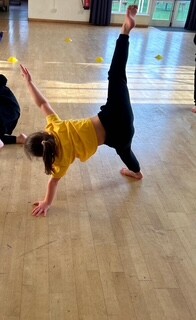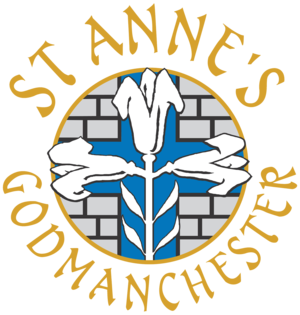PE (Physical Education)
As of January 2025 St Anne's Primary School will be using Get Set 4 PE as our scheme of work. 
At St Anne's we believe that a high-quality physical education curriculum will help all children to recognise the importance of leading healthy, active lifestyles; develop competences to excel across a broad range of physical activities; and inspire all children to engage in competitive sports and activities. We want all children to become physically confident in a way that supports their health and fitness. Physical Education will be used as a vehicle to build pupils’ character and teach the following key St Anne's values: joy, respect, creativity and resilience. Lessons will be planned to provide suitable challenge and support as necessary for all pupil groups, including; more-able, SEND, EAL, those with disadvantaged backgrounds and those with low prior attainment.

Active Learning as a distinct curriculum characteristic
Active learning as a distinct curriculum characteristic As a school, we place a high value on physical activity and its links to health, fitness and wellbeing. Therefore, our expectations of physical activity go beyond simply Physical Education as a subject area. Active learning is embedded into all subject areas across our School Curriculum. We believe active learning leads to healthy attitudes towards lifelong fitness and well-being. Additionally, active learning is essential to the personal development and learning of every child at St Anne's as it promotes interaction, communication and the sharing of ideas that enhance the entirety of each child’s learning experience.
Curriculum Intent
The following sections outline a summary of the physical education curriculum intent at St Anne's. Further detail of the curriculum intent and progression for the respective year groups can be found as part of the curriculum documents.
Early Years
In the EYFS children the most relevant learning outcomes relate to the ‘Physical Development’ (‘Moving and Handling’ and ‘Health and Self-Care’) and ‘Expressive Arts and Design’ areas of learning.
Children will:
• Have opportunity to experiment with and develop their confidence in different ways of moving.
• Jump off an object and land appropriately.
• Play running and chasing games with others, negotiating space and changing speed and direction to avoid obstacles.
• Travel with confidence and skill around, under, over and through balancing and climbing equipment.
• Show increasing control over objects in pushing, patting, throwing, catching and kicking.
• Balance momentarily.
• Initiate new combinations of movement and gesture in order to express and respond to feelings, ideas and experiences.
• Represent their own ideas, thoughts and feelings through dance.
• Show good control and coordination in large and small movements.
• Know the importance for good health of physical exercise, and a healthy diet, and talk about ways to keep healthy and safe.
• Experience handling different equipment safely with increasing control.
Key Stage 1
In Key Stage 1, children will develop fundamental skills, become increasingly competent and confident and access a broad range of opportunities to extend their agility, balance and coordination, individually and with others. The children will engage in competitive and co-operative physical activities, in a range of challenging situations. Children will take part in a variety of games, gymnastics, dance and athletic activities.
Games:
Pupils are taught:
• Simple competitive games, including how to play them as individuals and when ready, in pairs and in small groups.
• To develop and practice a variety of ways of sending, including throwing, striking, rolling and bouncing, receiving and travelling with a ball and other similar games equipment.
• Elements of games play that include running, chasing, dodging, avoiding and awareness of space and other players.
Gymnastics:
Pupils are taught:
• Different ways of performing the basic actions of travelling, using hands and feet, turning, rolling, jumping, balancing, swinging and climbing both on the floor and using apparatus.
• To link a series of actions both on the floor and using apparatus and how to repeat them.
Dance
Pupils are taught:
• To develop control, co-ordination, balance, poise and elevation in the basic actions of travelling, jumping, turning, gesture and stillness.
• To perform simple movements or patterns, including some from existing dance traditions.
• To explore moods and feeling and to develop their response to music through dances, by using rhythmic responses and contrasts of speed, shape, direction and level.
Athletics
In teaching units pupils concentrate on developing good basic running, jumping and throwing techniques. They are set challenges for distance and time that involve using different styles and combinations of running, jumping and throwing. As in all athletic activities pupils think about how to achieve the greatest possible height, speed, distance or accuracy. Pupils within this unit also prepare for sports day.
Key Stage 2
In Key Stage 2, the children will continue to apply and develop a broader range of skills, learning how to use them in different ways and link them to make actions and sequences in movement. We will provide the children with plenty of opportunities to allow them to enjoy communicating, collaborating and competing. Children will have the opportunity to take part in a variety of games, gymnastics, dance and OAA.
Games: Pupils are taught:
• Simple competitive games, including how to play them as individuals and when ready, in pairs and in small groups.
• To develop and practice a variety of ways of sending, including throwing, striking, bouncing, receiving and travelling with a ball and other similar games equipment.
• Elements of games play that include running, chasing, dodging, avoiding and awareness of space and other players.
Gymnastics:
Pupils are taught:
• Different ways of performing the basic actions of travelling, using hands and feet, turning, rolling, jumping, balancing, swinging and climbing both on the floor and using apparatus.
• To link a series of actions both on the floor and using apparatus and how to repeat them.
Dance
Pupils are taught:
• To develop control, co-ordination, balance, poise and elevation in the basic actions of travelling, jumping, turning, gesture and stillness.
• To perform simple movements or patterns, including some from existing dance traditions.
• To explore moods and feeling and to develop their response to music through dances, by using rhythmic responses and contrasts of speed, shape, direction and level.
Athletics
In teaching units pupils concentrate on developing good basic running, jumping and throwing techniques. They are set challenges for distance and time that involve using different styles and combinations of running, jumping and throwing. As in all athletic activities pupils think about how to achieve the greatest possible height, speed, distance or accuracy. Pupils within this unit also prepare for sports day.
Outdoor Adventurous Activities
Pupils take part in outdoor adventurous activities in a variety of ways including orienteering, team building activities, Forest School sessions and in Year 6 through a residential stay. They learn to complete challenges and problem solve both individually and as part of a team.
Below are the links for the PE Curriculum and Progression Documents.
Get Set 4 PE Curriculum Overview

